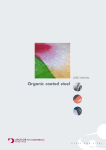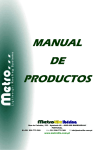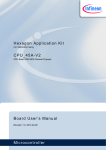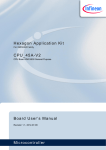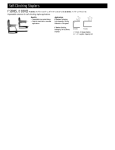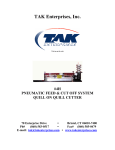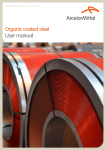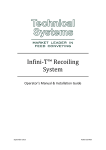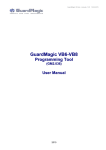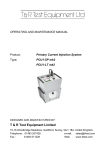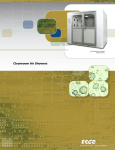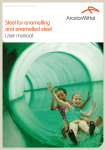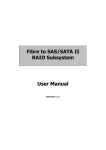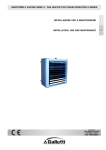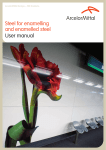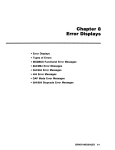Download Granite® Rain - ArcelorMittal Europe
Transcript
Flat Carbon Europe Granite® Rain Organic coated products for rainwater systems – Best practice guide Granite® Rain Organic coated products for rainwater systems Best practice guide ® GRANITE RAIN FOR RAINWATER SYSTEMS ArcelorMittal has developed a special range of organic ® coated products: Granite Rain designed specifically for rainwater systems (gutters, pipes and accessories). ® GRANITE RAIN FOR RAINWATER SYSTEMS Description and performance characteristics Steel grade and formability Chemical compatibility Environment Maintenance and cleaning GENERAL RECOMMENDATIONS FOR PROCESSING General recommendations Use of dedicated processing lines and storage facilities Manpower training Use of appropriate working temperature Providing inspection zones RECOMMENDATIONS FOR HANDLING, PACKAGING AND STORAGE Handling Packaging Storage Recommendations for decoiling, slitting, cutting etc RECOMMENDATIONS FOR FORMING OF GRANITE RAIN Introduction Roll forming Lock seaming Flanging Drawing Bending JOINING THE PARTS OF A RAINWATER SYSTEM Clinching Riveting ® ® The characteristic feature of the Granite Rain product range lies in the use of the same coating layers on both sides of the substrate. This ensures good colour consistency of rainwater system components, mainly the accessories, and very good performance on both sides. RAINWATER SYSTEM DESIGN Shape design Design support Organic coated steels for external use are generally composed of a steel substrate with a zinc-based metallic coating, a surface treatment layer, a primer and a topcoat. The choice of substrate has a direct influence on the processing performance and corrosion resistance of the organic coated product. For good corrosion resistance, a thick sacrificial zinc-based metallic coating such as Z275 is the minimum recommended for rainwater system applications. Z275 is the best choice, as it is compatible with forming operations and high corrosion resistance requirements. ® Each layer of Granite Rain coating fulfils a specific role: • The surface treatment ensures good bonding between the primer and the metallic coating. • The primer enhances the adherence of the topcoat and improves corrosion resistance. • The topcoat provides the required surface characteristics, such as final appearance, surface hardness and weathering resistance. ® Recommendations guide Granite Rain – Update: 10/01/2011 1/7 The overall performance and other characteristics required will, of course, vary greatly according to the type of substrate and the paint system selected. Description and performance characteristics The ArcelorMittal Granite organic coated products: ® Rain range comprises two • shape). A steel grade such as S220GD CBF (CoilBreak-Free) is recommended. For parts that are simply bent, the use of DX52 avoids the formation of most of the cracks that occur on small radii. Chemical compatibility ® • • ® Granite Rain HDX ® Granite Rain HDS These two products correspond to two different coating systems, with the associated performance characteristics. Their thickness and performance are specifically optimised for rainwater system applications, providing high weathering resistance and enhanced moisture barrier effect. Granite® Rain range Organic coating thickness Organic coating appearance Metallic coating Granite® Rain HDX Granite® Rain HDS 55 microns 35 microns Grained Grained Minimum Z275 Minimum Z275 The choice between these products depends on the environmental conditions to which the product will be exposed and the processing conditions. The appropriate choice is therefore crucial and should be made in close collaboration with ArcelorMittal’s technical and sales teams. ® ® Granite Rain HDX and Granite Rain HDS are selected in ® the Granite Rain range for their outstanding performance in weathering tests (corrosion resistance and colour stability), as indicated by the classification obtained according to EN 10169 standard. Granite® Rain range ® Granite Rain HDX Granite® Rain HDS UV resistance classification (EN 10169) RUV4 RUV4 Corrosion resistance classification (EN 10169) RC5 RC4 ® Granite Rain HDX has some additional advantages: • It has very good flexibility thanks to its very flexible coating. • It is easy to form even in a cold climate i.e. it can be processed and seamed at lower temperature. Steel grade and formability The mechanical properties of the components of a water drainage system are determined by the characteristics of ® the substrate used with Granite Rain products. The selection of the right steel grade obviously depends on the design of the parts, as well as the process used to obtain it. By way of an example: • • • Granite Rain has high-performance weathering resistance and good chemical resistance. Nevertheless, some precautions need to be taken: the components of the rainwater system should not be exposed to or come into contact with fluid flowing from copper or lead pipes or water containing either of these two ions. ® The material and/or components made with Granite Rain should not be stored or used in direct contact with or in close proximity to wet and corrosive materials such as wet concrete, wet timber, impregnated timber, soil or other wet materials. Environment ® The Granite Rain range is very resistant to corrosion, as demonstrated in corrosion classifications. However, ® Granite Rain durability can be altered when used in particularly corrosive or aggressive environments, e.g. in highly saline environments such as coastal areas (near saltwater), or when exposed to corrosive chemicals, corrosive fumes, condensation and ash, cement dust or manure. Details about the usage restrictions of Granite products can be found in the guarantee document. ® Rain Maintenance and cleaning The rainwater system components must be manufactured, handled and installed with care in order to avoid any damage, for example scratches, or the presence of iron filings or iron fragments on their surface. Once the system has been properly installed on the roof, effective maintenance starts with regular inspection – at least yearly – in order to take the necessary action and avoid, amongst other things: • Contact with incompatible materials (see above). • Any accumulation of water due to deposits of dirt, leaves or other debris. • Areas that are constantly wet. • Corrosion at the edge of the components. • Corrosion where there is an overlap (connection with other components of the system). • Paint problems. • Connections between the different components as well as at the fasteners. The system must be cleaned (minimum once a year) in order to ensure that the product continues to perform well, and to be in compliance with automatic guarantee rules. The components can be cleaned using a soft brush then washed with soapy water in order to remove any debris and avoid accelerated deterioration. Accessories like gutter angles, which are deep drawn, generally require a steel grade from within the DX53 (or better) to DX56 range. Linear sections, downpipes and parts that have small radii, with seamed joints, require a steel grade with sufficient elongation. In this case, something like S220GD is proposed. For round components, it could be useful to have steel with a fairly limited yield elongation in order to prevent panelling defects (flat facets instead of a round ® Recommendations guide Granite Rain – Update: 10/01/2011 2/7 GENERAL RECOMMENDATIONS FOR PROCESSING Important note The sections below define ideal processing situations and ® optimum working conditions for Granite Rain products. The recommendations given for each type of application guarantee success and complement the client’s own knowhow. General recommendations It is important to highlight that organic coated products are semi-finished products and that the final properties of ® components are determined by the properties of Granite Rain. Any alteration or weakness introduced during the processing stage will affect the quality of the final rainwater system component. Consequently, great care must be taken with all processing steps in order to ensure a highquality final product. This includes avoiding excessive deformation or damage to the surface, so as to preserve the corrosion resistance properties and attractive appearance of the product. This can be achieved by observing a few basic rules. Temperature is a parameter that should be taken into account during processing. ArcelorMittal’s general ® recommendation is to process Granite Rain products at room temperature (about 20°C). In extreme cases, the organic coated sheet can be heated locally by installing radiant infrared heaters on the processing line. ® In order to enlarge the processing window, Granite Rain HDX was specifically developed to be formed at lower ® temperature. Note that the flexibility of Granite Rain HDX will decrease with temperature but will remain at the correct level. In any case, coils, sheets and blanks should be conditioned in the workshop 24 hours prior to processing operations. Providing inspection zones Product inspection and monitoring should always be performed during processing, in order to detect defects such as scratches or indentations at the earliest possible stage. The ideal solution is to provide inspection zones with adequate lighting. Both sides of gutters and accessories must be examined. Use of dedicated processing lines and storage facilities There is a significant risk of contamination due to metallic particles when workshops and equipment are used for different products, such as metallic coated and coil coated steel. It is worth making an economic assessment of the potential benefits of investing in dedicated equipment for organic coated material, compared with the cost of producing batches of different products on the same line, including down time for cleaning and/or changing tools before organic coated material can be processed. Our technical and commercial teams can help you find the best solution for you, both technically and economically. Manpower training Working with organic coated products requires great care on the part of the operators. They should be aware of the constraints and should be given specific training. Operators do, in fact, need to be sensitive to the special care and different working methods required when dealing with a ® high-grade product like Granite Rain. RECOMMENDATIONS FOR HANDLING, PACKAGING AND STORAGE Handling Coils, sheets, blanks and components all need to be handled with care. The principal requirement is to ensure a soft contact surface that does not retain particles, dust etc. Coil handling equipment should have a protective coating and should be used with great care to avoid any hard impact that could mark the product. Operators should wear gloves when handling sheets manually to protect their hands from cuts. This also keeps the surface of the sheet clean. For automatic handling, numerous solutions are available, including robotic suction pad systems and permanent magnets. Manual or automatic handling operations may never involve sliding one sheet or component over another. Finally, when other handling systems are used, e.g. forklift trucks, it is often sufficient to add a sheet of felt or rubber to comply with the handling requirements for organic coated products. Packaging Use of appropriate working temperature Successful processing depends on the flexibility and hardness of the organic coating. The following graph shows how the working temperature affects these properties. ® As with other organic coated products, Granite Rain products are dispatched in packaging appropriate to the transport and handling conditions, the destination and the intended final use. This point should be discussed with the ArcelorMittal sales teams. ® The packaging of finished parts made with Granite Rain is important. The parts should be placed in boxes, baskets or other containers in such a way that they are separated from one another and protected against damage due to friction or impact. Storage The coils, sheets or blanks must be stored in clean, heated premises, which must be at least sufficiently ventilated to prevent moisture accumulation. Coils should not be placed directly on the ground, but on protective mats made of rubber, felt or similar material, to ® Recommendations guide Granite Rain – Update: 10/01/2011 3/7 prevent rough surfaces or debris causing marks or indentations on the first lap of the coils. Coils and bundles of organic coated strip must not be allowed to splay or be stacked on top of one another. The protection should be replaced on all partly used coils and bundles, in order to avoid soiling and damage to the exposed laps or sheets. ® It is recommended that Granite Rain should be used within six months of manufacture in order to conserve maximum flexibility of the organic coating. After six months, mechanical densification of the structure of the organic coating may occur, leading to loss of flexibility. Recommendations for decoiling, slitting, cutting etc Decoiling The drive system for decoiling must be matched to the line speed in order to optimise product flow. In extreme circumstances, the drive system will also eliminate jerks, and flapping and slipping of adjacent laps. Slitting, cutting to length, shearing, punching and mechanical cutting out ® Slitting and other cutting processes for Granite Rain strip are performed using the same parameters as for other products. It is essential to correctly adjust and sharpen tools to avoid the formation of burrs and paint slivers. Since there is no final painting operation to cover the burrs, they will remain visible. Paint slivers and built-up edges can also contaminate tools. This aspect is important, since it means that it is essential to stack the sheets perfectly vertically. The use of disk cutters and similar techniques should be ruled out, since they cause coating burns, and generate chips and burrs. For roll forming, for example, profilers will find hydraulic or pneumatic shears at the line exit preferable to circular or band saws. Furthermore, the choice of a suitable sheet handling system is important, particularly on punching presses. The new mini-brush types are to be preferred to the old ball systems. All these recommendations are particularly valid for rainwater system accessories, which are often obtained after slitting, nesting and perforation. Slitting, cutting-to-length and shearing operations must be considered at the design stage to ensure that any burrs that may result do not affect the appearance of the finished product or present a safety risk (cuts to the hands) during handling etc. The following rules must be respected in order to control the position of cutting burrs. The vertical and horizontal blade clearances for slitting are defined in the following figure: Slitting quality is considered to be good if: • The distorted zone is small • The shear zone occupies about a third of the thickness • The fracture zone is sharp, with an angle less than 5° • There are few or no burrs • There are no paint slivers or build-up on the tools Cutting to length with a shear gives burrs oriented in opposite directions on the front and rear edges of the sheet. ® Recommendations guide Granite Rain – Update: 10/01/2011 4/7 ® characteristics for coil coated steel are the flexibility and adherence of the coating in bends and its resistance to contact pressure and friction. From this point of view, too, ® Granite Rain is very successful. During forming of Granite Rain, both sides are in direct contact with the tools. The behaviour of the organic coating depends on the reaction of the material to the forming loads applied to the surface. The process parameters must be adapted appropriately. From the process point of view, in order to reduce the contact pressure between the rolls and the profile, there are two main requirements: firstly, the diameter of the rolls must be as large as possible and secondly, all sharp angles on the rolls must be eliminated and replaced by fillets. That is why it is recommended using dedicated equipment and workshops, with extremely clean machines and a working temperature at or above the glass transformation point (Tg) of the organic coating. In order to prevent slippage, the ideal solution is to have tools with counter-rolls mounted on bearings. This is a technically simple solution that creates no additional difficulty in terms of maintenance, and the initial investment is only marginally higher. RECOMMENDATIONS FOR FORMING OF GRANITE RAIN Introduction ® In order to avoid scratches or even tearing of the coating in extreme cases, the tool/sheet contact areas should be increased in order to decrease the local contact pressures and limit relative movements and friction between the tools and the organic coated steel. Increasing the contact area is not always easy to do directly, but can be readily achieved indirectly by polishing the tools. Relative movements depend on the forming process employed and it is often not simple to minimise them. However, the friction coefficient can be reduced. Polishing of the tools is again an excellent solution, and the use of appropriate lubrication is another possibility. Organic coated sheets will then have a very low friction coefficient, often less than 0.05 with steel tools. In cases where lubrication is necessary, it is important to choose the right lubricant. Volatile oils are to be preferred, since they generally eliminate the need for degreasing. The strain levels arising from the design of the component and the forming process must be compatible with the formability of the steel substrate, the metallic coating and the paint system. The thickness to be taken into account when designing a forming process is the total product thickness (steel + metallic coating + paint layers). It is this value that determines tool clearances. For thin gauges or applications requiring very precise adjustments, if the thickness of the coatings is not included in the calculation, the coating will be crushed. It is easy to make this mistake, since the organic coated steel thicknesses set out in the standards are the thickness of the steel substrate + metallic coating, but do not include the organic coating. Particular attention must be paid to the roughness and hardness of the rolls. The best roll materials are low or high alloy steels (35NCD4, 100C6, Z200C13 etc), quenched, ground and, if possible, polished. The application of a layer of chrome is the ideal solution. Whereas lubrication is essential in roll forming of metallic coated steel to prevent the coating sticking to the tools, it is ® often not necessary for Granite Rain, in view of its excellent properties. Furthermore, with complex profile geometries, it may be difficult to eliminate the lubricant. Volatile lubricant can help. With organic coated steel, in order to avoid damaging the paint coating, a suitable clearance must be taken into account. Naturally, it is the total sheet thickness that counts, including the organic coating. Lock seaming Like roll forming, lock seaming is a technique involving progressive plastic deformation of the steel to make the join. It is perfectly suitable for organic coated steel, providing that the metallic and organic coatings are chosen to withstand the strains generated in the folds. Lock seaming satisfactorily preserves the corrosion resistance of the coatings and can be easily combined with adhesive bonding. If necessary, the joint can be made perfectly leak-tight by the use of a sealing compound, an adhesive or a rubber seal. Wherever possible, the seam should be designed so that the sheet edges are not visible, both for aesthetic reasons and for optimum corrosion resistance. With lock seaming, folding strains are often severe, requiring the use of extremely flexible organic coatings. Roll forming The linear parts of the rainwater system (gutters and pipes) are obtained by roll forming. Accessories such as shoes, bends and downpipes are closed by seaming, which could be regarded as a particular type of roll forming. Example of use of roll forming for gutter To obtain an aesthetic roll formed part, certain requirements must be taken into account, associated with the product and the process. The most important Flanging The flanging technique is used for several accessories, such as brackets and stop ends. The control of strain during flanging, or edge forming, is similar to that in roll forming and bending processes. ® Recommendations guide Granite Rain – Update: 10/01/2011 5/7 Tool/work piece contact is different on the inside and outside surfaces of the bend. On the inside, contact occurs over a surface area and pressure is fairly light. In contrast, on the outside, contact with the punch (blade) is often linear and pressure is more acute. This is therefore where the potential difficulties lie. To minimise this problem, the tools must be polished, and this is especially important for the punch. Clearance must be sufficient to avoid crushing the paint layer. The punch edge radius should be as large as possible. Flap bending and narrow punch V-bending are two examples of types of bending. During bending, the pressures generated can be high, depending whether the contact occurs along a line (V-bending) or over a surface area (flap bending). JOINING THE PARTS OF A RAINWATER SYSTEM Clinching Drawing Most of the accessories of a comprehensive rainwater system are obtained by drawing on presses (e.g. gutter angles) or with small die sets. Clinching is an excellent method of joining organic coated sheets. With suitable precautions (see below), it preserves the corrosion resistance of the coatings. Clinching is a clean process, producing no fumes or slag. It is relatively quiet, and consumes little energy. It can be readily automated and easily integrated into various types of manufacturing lines (e.g. roll forming). Finally, clinched joints have good fatigue strength. Example of accessories made by drawing The strain levels must remain compatible with the deformation capacities of the substrate and the coatings. The different deformation modes (deep drawing, plane strain and expansion) each have specific effects. The pressures generated in drawing are relatively high and often reach 5 to 10 MPa. Friction must be closely monitored, since it can seriously damage the organic coating. Similarly, die entry radii should be increased as far as possible. The clearances between the punch and die should always be equal to the total thickness of the organic coated sheet plus 5 to 10%, depending on the case. ArcelorMittal can help you to assess the formability of a given part. Bending Some linear gutters are manufactured using a press brake and some accessories, such as gutter hooks, are obtained after successive bending operations. In bending processes, deformation strains can be controlled in the same way as for roll forming. However, the management of contact pressures depends on the bending process used. The clinching capacity of a sheet is directly linked to the grade of steel employed. In order to guarantee the attractive appearance of the clinched points, local lubrication with volatile oil may prove necessary. This will limit friction between the punch, the surface of the organic coated steel, and the die. Here again, heating is an excellent means of ensuring the flexibility of the organic coating and its formability during clinching. With regard to the appearance of the component, each clinching point produces a hump and a hollow. Since the static strength of a clinch is less than that of a spot weld, a greater density of points is required. The clinching tool must be perfectly perpendicular to the sheets and the punch must be precisely positioned with respect to the die. Riveting ® Riveting of Granite Rain requires no special precautions in addition to those required for cold rolled, galvanised or electrogalvanised steel. Blind riveting is a joining technique for which only one side of the joint needs to be accessible, since the hollow rivet is deformed by a central shaft. ® Recommendations guide Granite Rain – Update: 10/01/2011 6/7 RAINWATER SYSTEM DESIGN Shape design Component geometry has a direct influence on the strain undergone by the metal during forming. The choice of geometry therefore determines the feasibility of fabrication. ® For Granite Rain the same principles apply, but designers must also check that the organic coatings are able to withstand the deformations involved. It is therefore important not to introduce unnecessarily high strains at the design stage in order to have an optimum balance between the different functional property performances. Even a simple bending radius must be chosen with great care. The organic coating must be taken into account: it must have all the required properties and at the same time be able to withstand the forming strains. Pragmatic bending tests (EN 13523) can be useful to assess the organic coated steel’s ability to withstand the final component shape. In the case of the drawing process, the strains in the coating are more complex. These can be correctly estimated by simulation using finite element software, based on a preliminary geometrical definition of the component. They can also be determined experimentally by measurements on the component. We’re here to help you For further information on our products, please visit our document centre at www.arcelormittal.com/fce > Products & Services. Design support ArcelorMittal can support you in designing the components of your system, either by conducting a feasibility analysis in order to prevent any defects from the outset, by selecting the most appropriate steel grade and thickness based on optimisation of the formability safety margin, or – further down the line – by assessing the deformations inside your own fabricated parts. Or contact us direct at: [email protected] Copyright All rights reserved. No part of this publication may be reproduced in any form or by any means whatsoever, without prior written permission from ArcelorMittal. Care has been taken to ensure that the information in this publication is accurate, but this information is not contractual. Therefore ArcelorMittal and any other ArcelorMittal Group company do not accept any liability for errors or omissions or any information that is found to be misleading. As this document may be subject to change at any time, please consult the latest information on our website www.arcelormittal.com/fce ® Recommendations guide Granite Rain – Update: 10/01/2011 7/7








